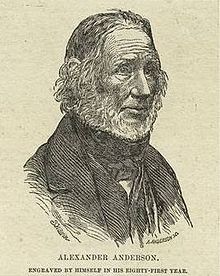Alexander Anderson (illustrator)

Dr Alexander Anderson (April 21, 1775 – January 17, 1870) was an American physician and illustrator.[1]
Biography

Anderson was born in
Another outbreak of yellow fever began in 1798, and Anderson returned to Bellevue as the resident physician. [4] He resigned a few weeks later after his three-month-old son, brother, and father all died in the epidemic. His wife and mother died soon afterwards.[6] Anderson then became an engraver and was termed "America's First Illustrator".[7]
He is one of the earliest American wood-engravers. He produced works for books, periodicals, and newspapers. Anderson is the author of the cartoon Ograbme, a spoof on the Embargo Act of 1807.[citation needed] He confined himself to wood engraving from 1820, and was engraver for the American Tract society for several years.[5] His work includes illustrations for Bewick's "Birds"; illustration for Webster's Speller, and forty engravings for an edition of Shakespeare.[5]
Anderson died in New York City on January 17, 1870, at the age of 94.[7][5]
Notes
- ^ Alexander Anderson | People | Collection of Smithsonian Cooper-Hewitt, National Design Museum
- ^ Kelly, Howard A.; Burrage, Walter L. (eds.). . . Baltimore: The Norman, Remington Company.
- ^ Oshinsky 2016, p. 19.
- ^ a b Oshinsky 2016, p. 20.
- ^ a b c d Johnson, Rossiter (1906). . . Vol. 1. p. 107 – via Wikisource.
- ^ Oshinsky 2016, pp. 26–27.
- ^ a b Oshinsky 2016, p. 27.
References
- Oak Knoll Press, New Castle DE 19720 & American Antiquarian Society, Worcester, MA 01609
- Oshinsky, David (2016). Bellevue: three centuries of medicine and mayhem at America's most storied hospital. Doubleday. ISBN 9780385523363.
- Pomeroy, Jane R. (2005). Alexander Anderson, 1775-1870, Wood Engraver and Illustrator, an Annotated Bibliography. New Castle, DE and Worcester, MA: Oak Knoll Press and the American Antiquarian Society.
- Pomeroy, Jane R. (2014). Alexander Anderson's New York City Diary, 1793 TO 1799. New Castle, Delaware: Oak Knoll Press and American Antiquarian Society.
Smithsonian, March 2021, pp14-18. The Fever That Struck New York: The front lines of a terrible epidemic, through the eyes of a young doctor profoundly touched by tragedy, by Carolyn Eastman.
External links
- Works by Alexander Anderson at Biodiversity Heritage Library
- The works of Alexander Anderson at the NYPL Digital Gallery
- The Alexander Anderson Print Collection at the New-York Historical Society
